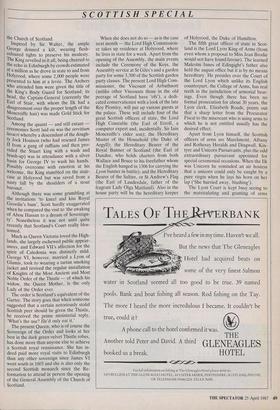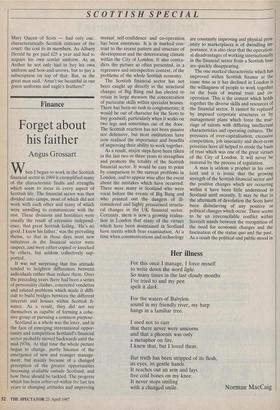Royal Britain
Court in the act
Hugh Montgomery- Massingberd The sorely missed Sir kin Moncreiffe of that Ilk, Scotland's most colourful cour- tier, used to describe himself as the Royal Company of Archers' second worst shot with a bow until Admiral Sir Angus Cun- ninghame Graham retired from the butts'. Whereas the Ilk's ill-aimed practice arrows tended to sink into the spreading chestnut trees at the Palace of Holyroodhouse, apparently the admiral managed to land an arrow on the roof.
Once when leaning on his bow as an Archer of the Queen's Body Guard at a royal garden party in the grounds of Holyrood, Sir kin overheard two Amer- ican guests exclaiming at the beauty of Scotland's age-old traditions, and lament- ing they had nothing like it in the States. In fact, many of these 'age-old traditions' owe almost everything to the romantic genius of Sir Walter Scott, who masterminded George IV's triumphal visit to Scotland in 1822.
This was the first time a sovereign had bothered to set foot in Scotland since 1651, though Bonnie Prince Charlie held court at Holyrood in 1745. In the meantime what little ceremonial survived from the era before the Act of Union in 1707 had attached itself to the temporary Lord High Commissioner to the General Assembly of
SCOTTISH SPECIAL
the Church of Scotland.
Inspired by Sir Walter, the ample George donned a kilt, wearing flesh- coloured tights to preserve his modesty. The King revelled in it all, being cheered to the echo in Edinburgh by crowds estimated at a million as he drove in state to and from Holyrood, where some 2,000 people were presented to him at a levee. The Archers who attended him were given the title of the King's Body Guard for Scotland; its head, the Captain-General (currently the Earl of Stair, with whom the Ilk had a disagreement over the proper length of the Moncreiffe hair) was made Gold Stick for Scotland.
Among the quaint — and still extant ceremonies Scott laid on was the servitium lavacri whereby a descendant of the dough- ty Jock Houison (who had rescued James II from a gang of ruffians and then pro- vided the Stuart king with a wash and brush-up) was in attendance with a silver basin for George IV to wash his hands. Possibly overcome with emotion at his welcome, the King stumbled on the stair- case at Holyrood but was saved from a nasty fall by the shoulders of a stout baronet.
Although there was some grumbling at the invitations 'to kneel and kiss Royal Geordie's bum', Scott hardly exaggerated when he compared the visit to 'the awaking of Abou Hassan to a dream of Sovereign- ty'. Nonetheless it was not until quite recently that Scotland's Court really blos- somed.
Much as Queen Victoria loved the High- lands, she largely eschewed public appear- ances, and Edward VII's affection for the spirit of Caledonia was distinctly mild. George VI, however, married a Lyon of Glamis, took to wearing a tartan smoking jacket and revived the regular installation of Knights of the Most Ancient and Most Noble Order of the Thistle — of which his widow, the Queen Mother, is the only Lady of the Order ever. The order is Scotland's equivalent of the Garter. The story goes that when someone suggested that a certain notoriously stolid Scottish peer should be given the Thistle, he received the prime ministerial reply, `What's the use? He'd only eat it.'
The present Queen, who is of course the Sovereign of the Order and looks at her best in the dark green velvet Thistle robes, has done more than anyone else to achieve a Scottish royal renaissance. She has in- deed paid more royal visits to Edinburgh than any other sovereign since James VI went south in 1603 and she is also only the second Scottish monarch since the Re- formation to attend in person the opening of the General Assembly of the Church of Scotland. When she does not do so — as is the case next month — the Lord High Commission- er takes up residence at Holyrood, where he lives in state for a week. Apart from the opening of the Assembly, the main events include the Ceremony of the Keys, the Assembly service at St Giles's and a garden party for some 3,500 of the Scottish garden party classes. The present Lord High Com- missioner, the Viscount of Arbuthnott (unlike other Viscounts those in the old peerage of Scotland have 'ofs'), a dedi- cated conservationist with a look of the late Roy Plomley, will put up various guests at the palace. These will include four of the great Scottish officers of state, the Lord High Constable (the Earl of Erroll, a computer expert and, incidentally, Sir Iain Moncreiffe's elder son); the Hereditary Master of the Household (the Duke of Argyll); the Hereditary Bearer of the Royal Banner of Scotland (the Earl of Dundee, who holds charters from both Wallace and Bruce to his forefather whom the English hanged in 1306 for carrying the Lyon banner in battle); and the Hereditary Bearer of the Saltire, or St Andrew's Flag (the Earl of Lauderdale, father of the fragrant Lady Olga Maitland). Also in the house party will be the hereditary keeper of Holyrood, the Duke of Hamilton.
The fifth great officer of state in Scot- land is the Lord Lyon King of Arms (from even whom a proposal to Miss Jean Brodie would not have found favour). The learned Malcolm Innes of Edingight's father also held the august office but it is by no means hereditary. He presides over the Court of the Lord Lyon which unlike its English counterpart, the College of Arms, has real teeth in the jurisdiction of armorial bear- ings. Even though there has been no formal prosecution for about 30 years, the Lyon clerk, Elizabeth Roads, points out that a sharp letter from the Procurator Fiscal to the miscreant who is using arms to which he is not entitled usually has the desired effect.
Apart from Lyon himself, the Scottish officers of arms are Marchmont, Albany and Rothesay Heralds and Dingwall, Kin- tyre and Unicorn Pursuivants, plus the odd extraordinary pursuivant appointed for special ceremonial occasions. When the Ilk was Unicorn he reminded an air hostess that a unicorn could only be caught by a pure virgin when he lays his horn on her lap (`She hurried away, blushing').
The Lyon Court is kept busy_ seeing to the matriculating and granting of arms
SCOTTISH SPECIAL
(currently about 100 of each a year). Lately there has also been a flurry of rescusita- tions of dormant Scottish peerages, with their conveniently wide remainders. When the Queen herself arrives at Holyrood — this summer she will be in residence from 26 June to 4 July — the Scottish court comes into its own. Apart from the five Scottish officers of state, the eight hereditary keepers of royal palaces. the heralds and pursuivants and the Captain-General of the Queen's Body Guard for Scotland, Her Majesty's house- hold in Scotland includes such worthies as the Deans of the Order of the Thistle and of the Chapel Royal, the Historiographer, the Painter and Limner, the Sculptor, the Astronomer and various medical men. The office of Limner was originally established by Queen Anne (`drawing pictures of our person or our successors or other of our royal family. . .') for a deaf and dumb Ogilvie.
The Queen's programme at Holyrood includes a double dose of the Ceremony of the Keys (with presentations by both the Lord Provost of Edinburgh and the Duke of Edinburgh); a garden party for 8,000: worship at the Canongate Kirk; an 'achiev- ers" dinner (similar to the 'informal' lun-
ches at Buckingham Palace) and the in- stallation of two new Knights of the This- tle, the Earl of Airlie and Sir lain Tennant. Before the Thistle ceremony the knights `He's a friend of James VI.'
are to give the Queen lunch at the Signet library.
Besides all the courtly ceremonial, the Queen will also be packing in such engage- ments as visiting St Columba's Hospice and Livingstone Newtown and opening a new Trustees Savings Bank. To help her carry out these duties she will be accompanied as usual by her standard travelling household. Significantly the ordinary household itself is headed by a Scottish Lord Chamberlain, Lord Airlie (Angus Ogilvy's banker brother). Meanwhile the Duke of Edin- burgh carries out his own engagements, notably the presentation of his awards.
Watching the Court in action at Holy- rood, one is struck by the typically Scottish combination of intimacy and grandeur. The great thing about the Scots is that they are content to be what they are. Your Scots courtier knows exactly where he stands; he knows that everybody else — everybody who matters as far as he is concerned knows who he is and knows that his ancestors in the reign of Mary Stuart occupied much the same position in the aristocracy of Scotland as he does now.
It is all very reassuring. One only wishes more state visits could be arranged by way of Edinburgh; those of the Kings of Nor- way and Sweden were memorably success- ful.
Sir Iain Moncreiffe — who never tired of pointing out to his compatriots that the Queen was not just a nice Anglicised German but, through her father, the nearest Protestant heir of the blood of
SCOTTISH SPECIAL
Mary Queen of Scots — had only one, characteristically Scottish criticism of the court: the cost to its members. As Albany Herald he got paid £25 a year and had to acquire his own scarlet uniform. As an Archer he not only had to buy his own uniform and bow-and-arrows, but to pay a subscription on top of that. But, as the great man said, 'Aren't we beautiful in our green uniforms and eagle's feathers?'





































































 Previous page
Previous page